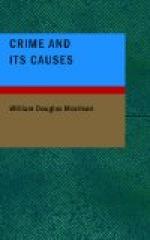Italy, 1880-84 Annual trials for theft per 100,000
inhabitants 221
France, 1879-83 do.
do. 121
Belgium, 1876-80 do.
do. 143
Germany, 1882-83 do.
do. 262
England, 1880-84 do.
do. 228
Scotland, 1880-84 do.
do. 289
Ireland, 1880-84 do.
do. 101
Hungary, 1876-80 do.
do. 82
Spain, 1883-84 do.
do. 74
To what conclusions do the statistics contained in this table point? It is useless burdening this chapter with additional figures to prove that England and France are the two wealthiest countries in Europe. The wealth of England, for instance, is perhaps six times the wealth of Italy; but, notwithstanding this fact, more thefts are annually committed in England than in Italy. The wealth of France is enormously superior to the wealth of Ireland, both in quantity and distribution, but the population of France commits more offences against property than the Irish. Spain is one of the poorest countries in Europe, Scotland is one of the richest, but side by side with this inequality of wealth we see that the Scotch commit, per hundred thousand of the population, almost four times as many thefts as the Spaniards. With the exception of Italy it is the poorest countries of Europe that are the least dishonest, and, according to our table, even the Italians are not so much addicted to offences against property as the inhabitants of England.
Perhaps the most instructive figures in these international statistics are those relating to England and Ireland. The criminal statistics of the two countries are drawn up on very much the same principles; the ordinary criminal law is very much the same, and there is very much the same feeling among the population with respect to ordinary crime; in fact, with the exception of agrarian offences, the administration of the law in Ireland is as effective as it is in England. On almost every point the similarity of the criminal law and its administration in the two countries almost amounts to identity, and a comparison of their criminal statistics, in so far as they relate to ordinary offences against property, reaches a high level of exactitude. What does such a comparison reveal? It shows that the Irish, with all their poverty, are not half so much addicted to offences against property as the English with all their wealth, and it serves to confirm the idea that the connection between poverty and theft is not so close as is generally imagined.




